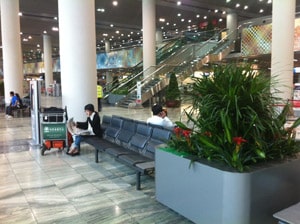Green Airport
Green Project
Green Wall


Vehicle Replacement
As part of the Carbon Management Plan, until the end of 2024, MIA had replaced and purchased eight hybrid and five electric vehicles.





Green the Airport with Various Plants
All kinds of plants are located in different areas of the terminal building, namely: Calathea Makoyana, Rhapis excelsa, Fagraea ceilanica, Schefflera arboricola and Dracaena “Lemon Lime” placed in departure lounge. The plants rotate every season. Green plants can reduce emission of carbon dioxide, purify air and improve air quality, MIA determine to provide a memorable green airport experience for the all passengers!





Replacement of Airfield Ground Lighting (AGL) and Terminal Lightings
Since 2013, with the subsidy from Environmental Protection and Energy Conservation Fund of Macau SAR Government, MIA had replaced the traditional Taxiway Edge Lights, Stop Bars, Taxiway and Apron Centre Line Lights. Starting from 2014, MIA had been continuously replacing the traditional lights in various areas of the Passenger Terminal Building with energy saving LED lights. These areas include offices, staff corridors, make-up area and hangars. Since 2017, CAM had also invested in replacing the Sequential Flashing Lights (SFL) and Runway Threshold Identification Lights (RTIL) on both Runway 16 and 34 with LED. After the replacement of the lights in the abovementioned areas, at least 542 tonnes CO2/year can be saved.





Replacement of Chillers to Energy Efficient Models
In 2022, MIA had replaced the aging chillers with energy efficient models. After the replacement of chillers, total electricity consumption had decreased 11% in 2022 compared to that of 2021. These chillers consume more environmental-friendly type of refrigerant, which has a lower global warming potential than the type of refrigerant used for the previous chillers, therefore contributed to reduced carbon emissions.


